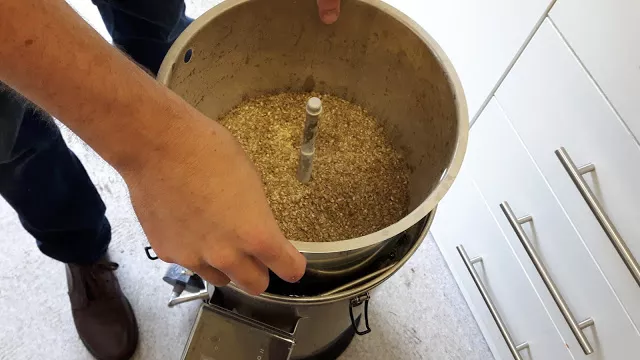This week, Dave and Mark from our UK office did some experimentation with a technique first coined by Chris Colby back in 2007. The technique is called ‘reiterated mashing’ and seems perfectly suited for people hoping to brew higher ABV beers in the Grainfather. Read on below to find out how!
 |
| Chris Colby, using the Grainfather at NZ Homebrewers Conference 2016 |
“Brewing high ABV beers can be a tricky thing for many homebrewers. Due to the relatively small size of vessels we use for brewing in we are often limited for how much grain and water we can mash with, so brewing higher ABV beers by simply increasing the amount of grains that we use is often out of the question.
Well, there are other options available to us. Adding a lot of adjuncts such as sugar or malt extract can provide a boost to the ABV but naturally these will have an effect on the finished beer that needs to be accounted for and are relatively expensive in comparison to brewing solely from grain.
We could try collecting the maximum volume we can achieve in our systems and then boil it down for as long as we dare, giving us an exceptionally concentrated wort. The issue with this is the added cost and time of boiling for this long, the caramelisation and darkening of the wort that will occur in an extended boil – making it difficult to create a high ABV, pale beer and the smaller volume that we will collect into our fermenters. Maybe not a problem if you only want a small amount of high ABV beer but if you wanted 23 L (6 US Gal) in your fermenter your preboil volume would be considerably larger than usual.
We could also mash as normal and then simply collect the first runnings without sparging which will give a higher preboil gravity but after losses to the grain and losses to the boil and trub you will be collecting quite a small volume again and it is quite an inefficient use of your grains.
Reiterated mashing gives us another option. The basic idea is that you perform multiple mashes, using the wort created in the previous mash as the brewing liquor for the next. Clear as mud?
It becomes simpler if you look at it as a series of brewing stages;
1. Start with your initial grain bill and the necessary volume of mash water. You will be mashing the same grist each time you mash. Say you start with 5.5 kg (12 lb) of grain, you will need 18.1 L (4.8 US Gal) of mash water and 14.1 L (3.7 US Gal) of sparge water.
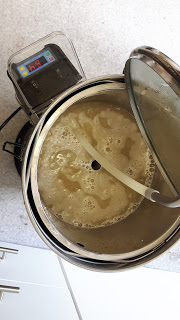 |
| Recirculating the mash |
2. Mash in as usual and recirculate. We mashed for the full 60 minutes. Pull up your grain basket and let it drain before you begin your sparge.
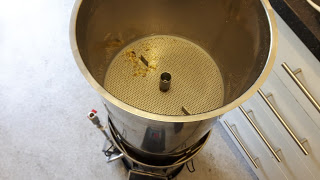 |
| The Sparge |
3. At the end of your sparge empty the grain basket of your first grain bill, put the grain basket back into your Grainfather and begin mashing directly into the wort for your second mash. Once all of your second grain bill is added begin recirculation and mash for an hour.
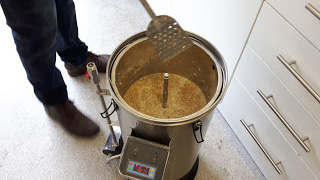 |
| Second Mash |
4. At the end of this second mash, sparge to bring the volume back to 28 L (7.4 US Gal) and start the boil as normal. Alternatively you could do a third mash at this stage to raise the start gravity even higher.
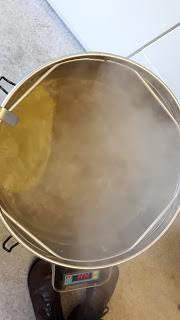 |
| Boiling |
Mark and I decided we needed to try this out and what better beer to try it with then a big, double IPA. We settled on the following recipe;
Mark’s Double Hard Bastard
Mash 1
5kg (11 lbs) Maris Otter
0.25kg (0.55 lbs) Carapils
0.25kg (0.55 lbs) Wheat
Mash 2
5kg (11 lbs)Maris Otter
0.25kg (0.55 lbs) Carapils
0.25kg (0.55 lbs) Wheat
Hops
65g (2.29 oz) Magnum @ 60 mins
61g (2.15 oz) Citra @ 0 mins
61g (2.15 oz) Equinox @ 0 mins
61g (2.15 oz) Motueka @ 0 mins
Yeast
2 x Mangrove Jack’s M44 US West Coast
We kept the recipe extremely simple – as with many American double IPAs the focus is on the hops and an overly complex malt bill can muddy their contribution, plus at a higher ABV the final gravity was likely to be fairly high so we didn’t want any caramel or crystal malts to further contribute sweetness and throw the beer off balance.
After our first mash and sparge our reading was a low 1.048 but after our second mash, our pre sparge gravity came in at 1.092. Our start gravity in the fermenter was 1.086 which means, based on M44 US West Coast’s usual attenuation we should end up with a beer somewhere between 8.8-9.7% ABV.
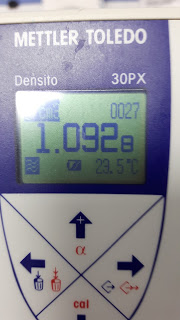 |
| Gravity reading |
We will be dry hopping this beer with a mixture of Citra, Equinox and Lemondrop after 5 days in the fermenter.”
